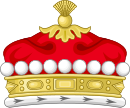| Viscountcy of Slim | |
|---|---|
  Gules semy of Swords erect Argent a Lion rampant Or on a Canton quarterly Azure and also Argent a Mullet of seven points Gold | |
| Creation date | 15 July 1960 |
| Created by | Queen Elizabeth II |
| Peerage | Peerage of the United Kingdom |
| First holder | William Joseph Slim, 1st Viscount Slim |
| Present holder | Mark William Rawdon Slim, 3rd Viscount Slim |
| Heir apparent | the Hon. Rufus William Rawdon Slim |
| Status | Extant |

Viscount Slim, of Yarralumla in the Capital Territory of Australia and of Bishopston in the City and County of Bristol, is a title in the Peerage of the United Kingdom. It was created in 1960 for Field Marshal Sir William Slim upon the end of his term as Governor-General of Australia. [1]
Contents
Until 2019, the title was held by his son, the second Viscount, who succeeded in 1970 and was one of the ninety elected hereditary peers that remain in the House of Lords after the passing of the House of Lords Act of 1999, and sat as a crossbencher.
His son, the 3rd Viscount, is a chartered surveyor and a director of malt suppliers Muntons plc.
